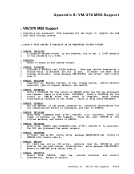error condition),
disconnect
or reconnects the user
another
if he was running in
until now), virtual storage size, and other vital information in
the virtual
(necessary
storage).
and
for
initializes segment, page,
handling of the virtual
and swap
machine's
tables
virtual
machine has the ability to run in the extended control
blocks, and channel blocks, using
device blocks portion of the directory.
the directory, the accessibility of any disk being determined by
the user access
users are presently linked to the disk, in read
write aode.
as reader, punch, printer, and terminal.
revision to the system
of any outstanding spooled files in his virtual reader, printer,
or punch.
weekday), and a aessage to the system operator indicating that
the user has
If the virtual aachine has a device address or a
directory and the initialization
functions are
alternate nucleus by using the
option causes the
loading the initial
user's terminal in
location
entered in location
1-124








































































































































































































































































































































































































































































